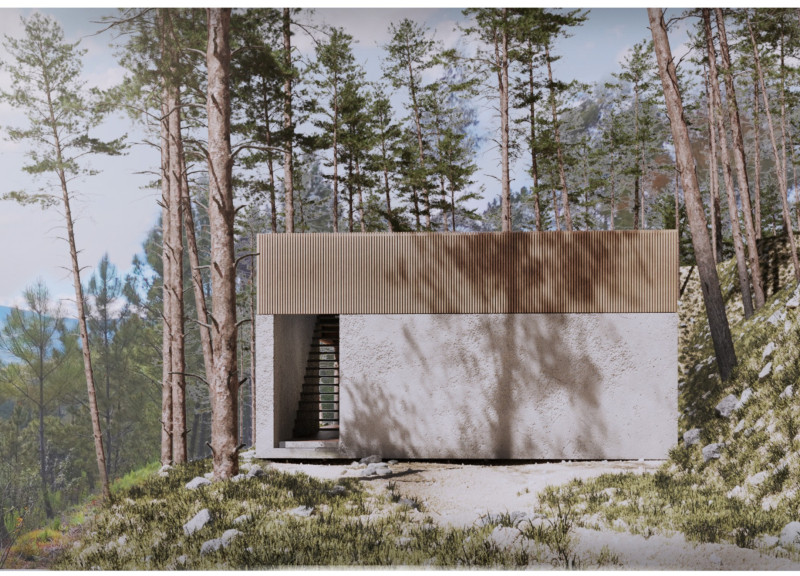5 key facts about this project
The design represents a modern approach to living that prioritizes ecological mindfulness and the use of natural materials. The building is carefully situated within the site to capitalize on the existing topography, preserving the integrity of the landscape while maximizing views of the forest. The overall architectural form is characterized by clean lines and a straightforward geometric layout, which convey a sense of simplicity and elegance. This is complemented by a flat roof that unifies the structure, reinforcing its minimalist character while also allowing for the installation of a green roof, which serves as both insulation and a biodiversity hotspot.
A crucial component of the project is its materiality, which includes concrete, wood, and glass. The use of concrete for the walls ensures durability and stability, while the earthy tones create a nuanced dialogue with the surrounding trees. Wood is incorporated not only as a cladding material but also features in various interior elements, introducing warmth and establishing a sensory connection to the environment. The expansive glass windows are a defining feature of the design, providing ample natural light while allowing residents to enjoy unobstructed vistas of the woodland.
The interior of the building is designed as an open-plan space that fosters a sense of spaciousness and facilitates movement between different areas. This layout encourages social interaction and enhances the overall living experience. The inclusion of panoramic windows further reinforces the connection between inside and outside, creating an immersive atmosphere where residents can experience the changing qualities of light and nature throughout the day. This approach to design promotes a lifestyle that values tranquility and mindfulness.
Unique design ideas manifest in several aspects of the project. The integration of renewable energy solutions, such as solar panels on the green roof, highlights a forward-thinking approach to architecture that prioritizes environmental responsibility. Additionally, the careful consideration of the building's orientation ensures optimal natural ventilation and thermal performance, minimizing reliance on artificial heating and cooling systems. This not only reduces the ecological footprint but also augments the comfort of the living space.
The architectural details of the project, from the wooden slat ceiling to strategically placed overhangs, demonstrate an attentiveness to both functionality and aesthetic appeal. These elements are thoughtfully crafted to provide shelter and protection from the elements while enhancing the structure's visual hierarchy. The result is a cohesive design where every aspect, from the layout to material choices, comes together to create a serene environment that resonates with the surrounding landscape.
This architectural project is a testament to the potential of modern design to integrate seamlessly with nature while prioritizing sustainability and user experience. By exploring the architectural plans, sections, and various architectural ideas presented within this project, readers can gain deeper insights into its thoughtful conception and execution. Engaging with these elements allows a fuller appreciation of how this architectural endeavor successfully bridges modern living with the intrinsic beauty of its natural setting. Visitors are encouraged to explore the project presentation further to delve into the specifics of this innovative design.


























